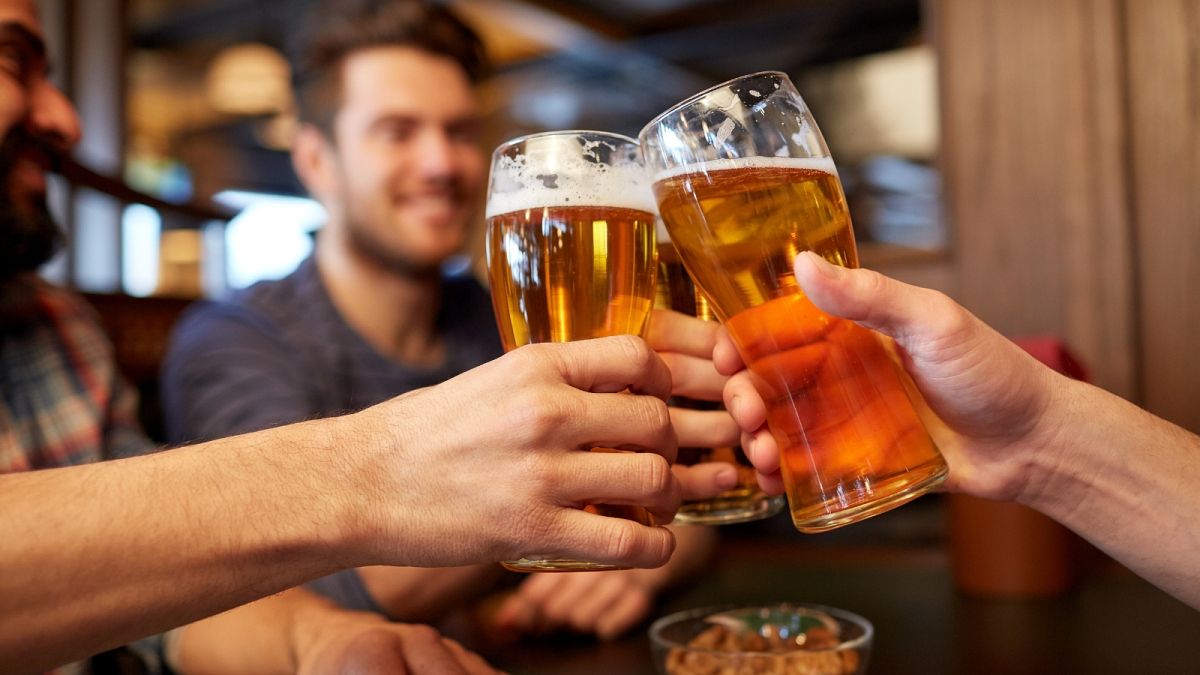Alcohol consumption in the EU has declined by 0.5 litres between 2010 and 2020. However, there are several countries where consumption increased.
"No level of alcohol consumption is safe for our health," the World Health Organization (WHO) warns. However, the amount of alcohol that we drink is still significant.
The risk of developing cancer increases considerably when more alcohol is consumed. Health authorities call for people to stop drinking alcohol or at least to reduce it.
But do we consider these calls?
Some people stop drinking alcohol in January, for so-called "Dry January". The figures indicate a decline in alcohol consumption in Europe, but it has been slowing since the 2000s.
How did alcohol consumption change across Europe in the last decades? Which countries have the highest rate of decrease and rise in alcohol consumption?
Overall alcohol consumption is defined as the annual sales of pure alcohol in litres per person aged 15 and over. Alcohol drinks are converted to pure alcohol. The data does not include unrecorded alcohol consumption, such as domestic or illegal production.
There is a gradual decrease in alcohol consumption in the EU and WHO's European Region.
In the EU, overall alcohol consumption per person aged 15 years and over dropped by 2.9 litres in the last four decades, falling from 12.7 litres in 1980 to 9.8 litres in 2020, which corresponds to a 23 per cent decrease.
The consumption recorded a significant decrease between 1980 (12.7 litres) and 2000 (10.5 litres).
The amount and rate of decrease slowed in the following two decades. It dropped by 0.5 litres between 2010 and 2010 in the EU.
The alcohol consumption in the WHO’s European Region, which covers 53 countries including Russia and surrounding countries, fell from 12 litres in 2000 to 9.5 litres in 2020, corresponding to 2.5 litres decrease (21 per cent).
Despite this drop, the WHO European Region still has the highest level of alcohol consumption per person in the world.
Annually, every person, who is 15 years and above in the Region, drinks on average 9.5 litres of pure alcohol. This is equivalent to 190 litres of beer, 80 litres of wine or 24 litres of spirits.
In 2020, annual alcohol consumption varied from 1.2 litres in Turkey to 12.1 litres in Latvia among 36 European countries including the EU, the UK, the European Free Trade Association (EFTA) and EU candidate countries.
On average, EU citizens consumed 9.8 litres of alcohol.
Germany (10.6 litres) had the highest amount of alcohol consumption, among the EU's "Big Four" in terms of economy and population, followed by France (10.4 litres), Spain (7.8 litres) and Italy (7.7 litres). It was 9.7 litres in the UK.
Looking at country-level changes between 2010 and 2020, alcohol consumption fell in 25 countries whereas it increased in 11 countries.
Some recorded slight changes but most countries displayed remarkable changes in this period
Consumption dropped by more than one litre in 14 countries
Alcohol consumption experienced a decline of over one litre in 14 countries, while conversely, it saw an increase in 5 countries in this period.
Ireland and Lithuania recorded the highest decline in alcohol consumption in this period. It dropped by 2.1 litres in both countries, closely followed by Spain and Greece (both 2 litres).
The Netherlands, France, Cyprus and Finland also recorded above 1.5 litres declines. The amount of decrease was also between one litre and 1.5 litres in Serbia, Belgium, Croatia, Denmark, Switzerland and Germany.
In the EU, alcohol consumption dropped by 0.6 litres between 2010 and 2020.
Latvia had the highest increase where the consumption rose by 2.3 litres.
Bulgaria (1.4 litres), Malta (1.1 litres), Romania and Poland (both 1 litres) also showed substantial increases. The rise was above 0.5 litres in Norway, Italy and Iceland.
As alcohol consumption significantly varied across Europe, looking at the percentage change is also a useful indicator.
Greece displayed the highest decrease by 24.1 per cent, followed by the Netherlands (20.9 per cent), Spain (20.4 per cent) and Turkey (20 per cent).
The decline rate was also over 15 per cent in Ireland, Serbia, Lithuania, Finland, France and Cyprus.
Latvia (23.5 per cent) had the highest rise in percentage change, too.
Many European countries have implemented a range of policies to limit alcohol consumption, such as taxation, restrictions on alcohol availability and bans on alcohol advertising.
However, their effectiveness is hindered by poor implementation on the ground and limited resources according to the OECD.
Role of gender and education in heavy drinking
Alcohol consumption substantially differs by gender and education. Rather than the amount, the proportion of heavy episodic drinkers is surveyed.
It is the share of adults aged 18 years and over who reported having had 60 grammes or more of pure ethanol on a single occasion in the past 30 days. That's equivalent to 6 drinks or more.
In 2019, nearly one in five adults (19 per cent) reported heavy episodic drinking at least once a month in the EU countries, a proportion that has remained stable since 2014.
In all countries, men were more likely than women to report heavy episodic drinking. In 2019, on average across the EU countries, 26.6 per cent of men reported heavy episodic drinking at least once a month compared to 11.4 per cent of women.
The highest proportion of heavy episodic drinking in men was reported by Romania (55.2 per cent). This rate was above 35 per cent in Denmark, Luxembourg, Germany and Belgium.
Women in Denmark, Luxembourg, Germany and Ireland displayed the highest rates of heavy episodic drinking, which was above 20 per cent.
The ratio of heavy drinkers in men to women demonstrates the gender gap. In 2019, this was 2.33 in the EU, indicating that 2.33 men were heavy drinkers in contrast to women. This ratio was the lowest in Ireland (1.46), Iceland (1.63) and Germany (1.74).
Turkey and Cyprus were outliers in the gender-heavy drinking gap where this ratio was over 8.
The academic research suggests that gender differences may be related to different cultural expectations and reflect traditional gender roles. It may also be associated with the gender employment gap and lower income.
Heavy drinking is lower in people with lower education. Why?
Education level also matters in heavy drinking. People with lower education levels do not have a higher rate of heavy episodic drinking in EU countries, except in Latvia.
On average, 12.5 per cent of people with less than upper secondary education reported heavy episodic drinking, compared to 20 per cent or more of people with at least upper secondary (22.3 per cent) or tertiary education (20.2 per cent).
These differences significantly reflect greater purchasing capacity.
"Alcohol is more affordable for people with more education and higher incomes. However, when looking at alcohol-related harm, the burden is greater on people with lower socio-economic status," the OECD's 'Health at State of Health in the EU Cycle-2022' report found.
The highest rate of education heavy drinkers gap was seen in Latvia, Greece, Estonia, Bulgaria and Lithuania.
In these countries, the rate of heavy episodic drinking in people with lower education was slightly higher than with tertiary education.
Is there a safe level of alcohol use?
It's a simple question with a simple answer: no, there is not.
"We cannot talk about a so-called safe level of alcohol use. It doesn’t matter how much you drink – the risk to the drinker’s health starts from the first drop of any alcoholic beverage," Dr Carina Ferreira-Borges, acting Unit Lead for Noncommunicable Disease Management and Regional Advisor for Alcohol and Illicit Drugs in the WHO Regional Office for Europe explained.
However, the amount of alcohol is still important.
"The only thing that we can say for sure is that the more you drink, the more harmful it is – or, in other words, the less you drink, the safer it is," Ferreira-Borges said.



